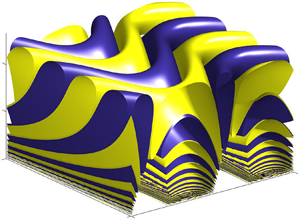No CrossRef data available.
Article contents
On the near-wall instability of oblique flow over a wavy wall
Published online by Cambridge University Press: 01 July 2022
Abstract

The instability of a shear flow passing over a wavy wall with wave crests not perpendicular to the flow direction is investigated. The friction Reynolds number for the flow is large and the wave amplitude scaled on the wavelength is small compared with the viscous wall layer. The instability takes the form of a streamwise vortex of wavelength comparable to the viscous wall layer in which the basic flow adjusts to the presence of the wall. For a given wall amplitude, the instability considered is the first one to arise as the Reynolds number is increased and modes of wavelength comparable to the viscous layer grow much faster than modes of wavelength comparable to the wall wavelength. The instability is not driven by centrifugal or viscous effects but is a novel kind of cross-flow vortex instability associated with a spatially periodic flow; the existence of the instability is associated with the orientation of the wave crests. The instability is investigated for wavelengths comparable to the depth of the viscous wall layer; the limiting cases of large and small wavelengths are investigated asymptotically. At small wavenumbers and roughness heights the instability connects with disturbances of wavelength comparable to the wall wavelength. At high wavenumbers and roughness heights a new structure emerges and the disturbance moves away from the wall, that structure takes on a self-similar form with progressively faster variations in the streamwise and spanwise directions as the roughness height increases.
- Type
- JFM Papers
- Information
- Copyright
- © The Author(s), 2022. Published by Cambridge University Press





